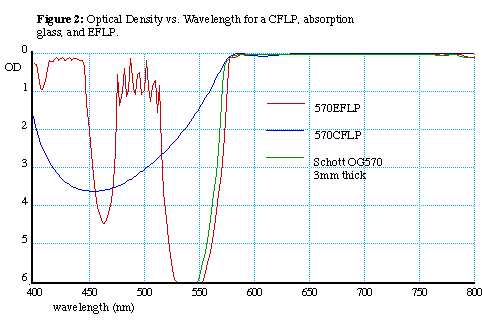|
Home Page | Products | Contact Us | News & Events | Request Info. |
||||
|
|
Optical Filters for All Occasions |
|
||
|
|
||||
|
|
Longpass & Shortpass FiltersLongpass and shortpass filters transmit only above or below a certain "cut-on" or "cut-off" wavelength and continue to transmit a wide energy band. They are used in diverse applications such as detection of fluorescence emission, colour separation in TV and photography, and spectral band isolators. These filters can be designed for use in reflection and transmission mode, and can be used as beamsplitters or combiners. Cut-On (CF) filters typical of the industry standard for these filters, the cut-on filter series provides peak transmission of 85 to 90% while blocking a region typically 99.9%. These filters have a shallow edge slope between reflection and transmission. Edge (EF) filters provide a high-performance longpass or shortpass filter that complements the DF series Bandpass filters. These filters feature very steep edge slopes and a narrow (30 - 80nm) band of attenuation by reflection. Typical configuration includes sharp cut-on absorption glass substrates to attenuate a greater wavelength range. Raman Edge (REF) filters are optimized for deep attenuation (> OD 6) and are available for custom applications.
UV Raman Edge FiltersWe are currently pushing the limits of optical thin-film technology to produce environmentally stable UV Raman edge filters using ALPHA technology. These filters exhibit steep edge slopes, deep blocking of the laser line, and high throughput of the Raman signal. The performance features are superior to low throughput monochromators, at far less cost. Beyond the obvious cost advantages, these coated windows are compact and exhibit very high contrast between the Rayleigh and Raman transmission. Raman edge filters are constructed of an exposed, front surface hard oxide coating on an optical quality substrate. Using ion assist technology produces durable filters with no detectable wavelength shifting under different moisture conditions. We are capable of producing filters for laser wavelengths as low as 229nm, and we are currently exploring the options of pushing this limit to lower wavelengths. In the UV wavelength region, we can currently produce edge filters with 5-decade slope factors as low as 3%. The 5-decade slope factor (c5) is defined by:
where l OD=5 is the wavelength at which optical density 5 is achieved, and l OD=0.3 is the wavelength at which the optical density is 0.3, or equivalently, the transmission is 50%. The filter in the example above is designed to block the 248nm laser line at OD=5, and transmit 50% at 256nm. Angle-tuning the filter (up to about 15° from normal incidence) will blue-shift the transmission curve and allow Raman signals closer to the laser line to pass through the filter, at some expense to blocking at the laser line. Another option for achieving higher transmission at low Raman shifts is to use two filters in series, each designed to block the laser line at OD=2-3 levels. Used in combination, the blocking at the laser line is additive (OD=4-6) and the 5-decade slope factor is effectively decreased from 3% to as low as 1.5%. See also Raman Filters
|
|
Back to top | Home Page | Products | Contact Us | News & Events | Request Info. |
|
|
|
|
|
|
|
|
Copyright © 2007 Glen Spectra All rights reserved |
|



